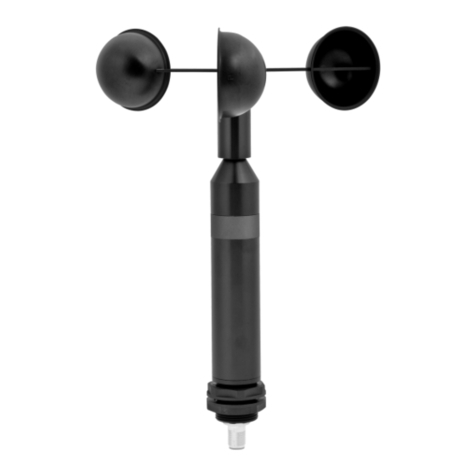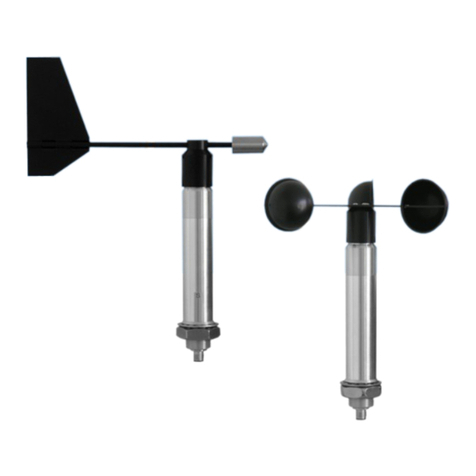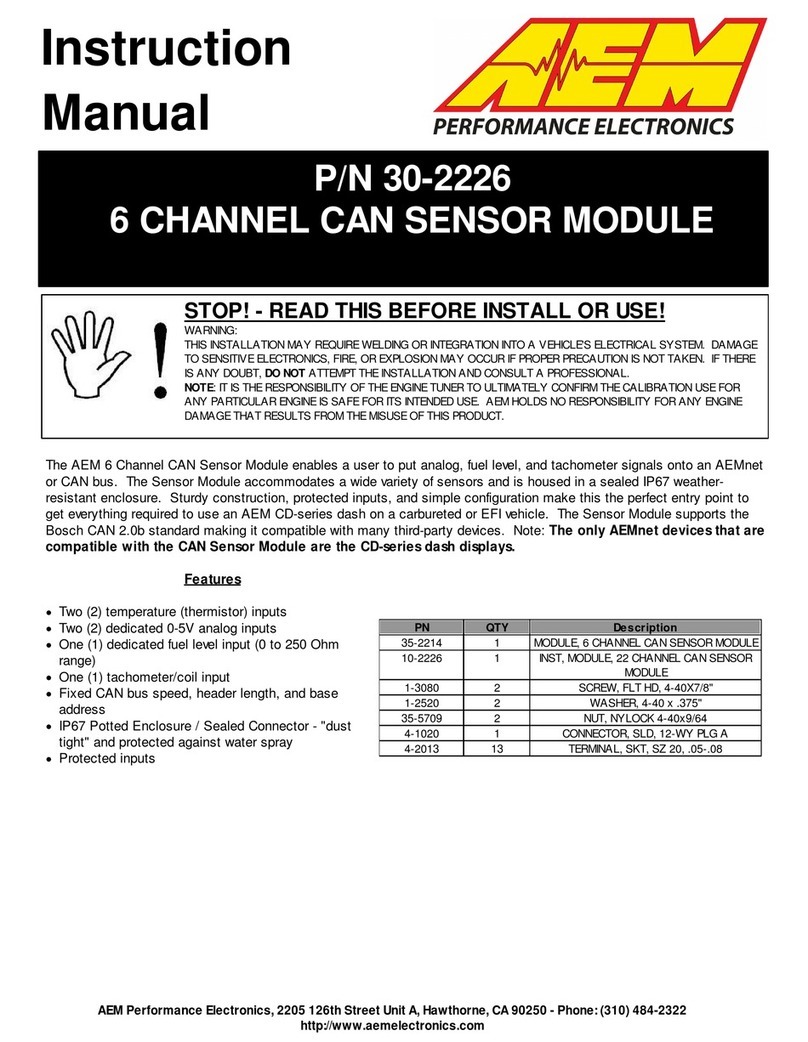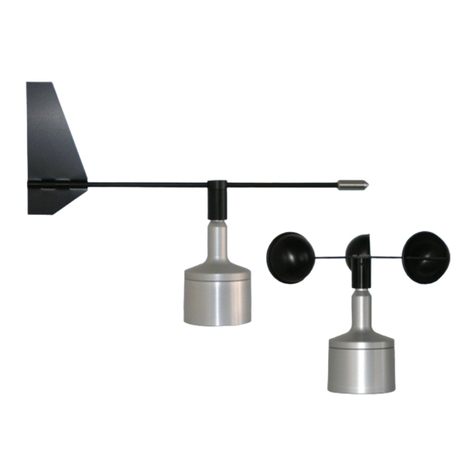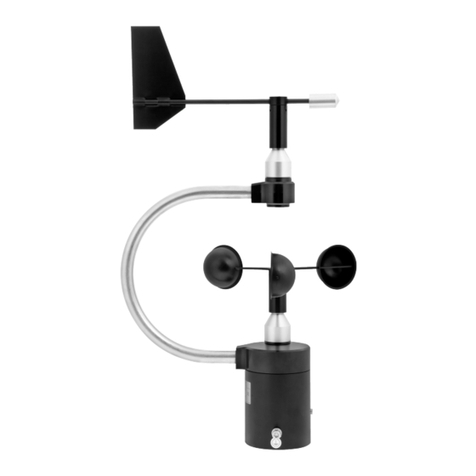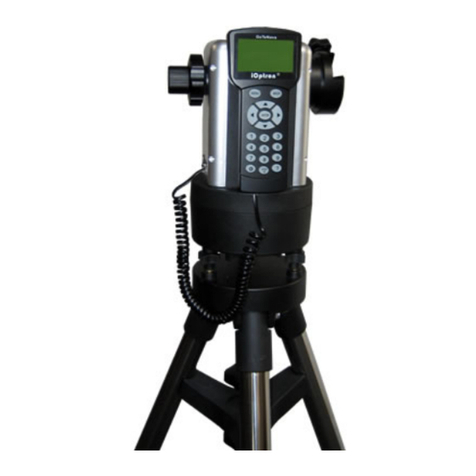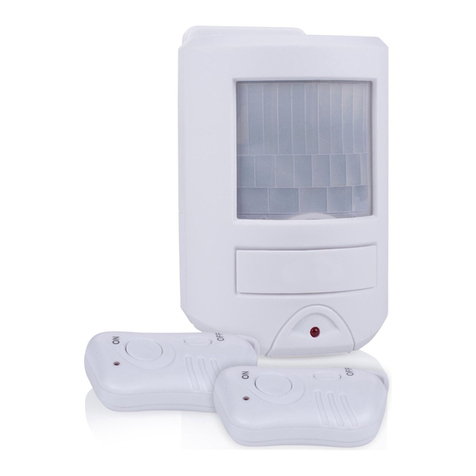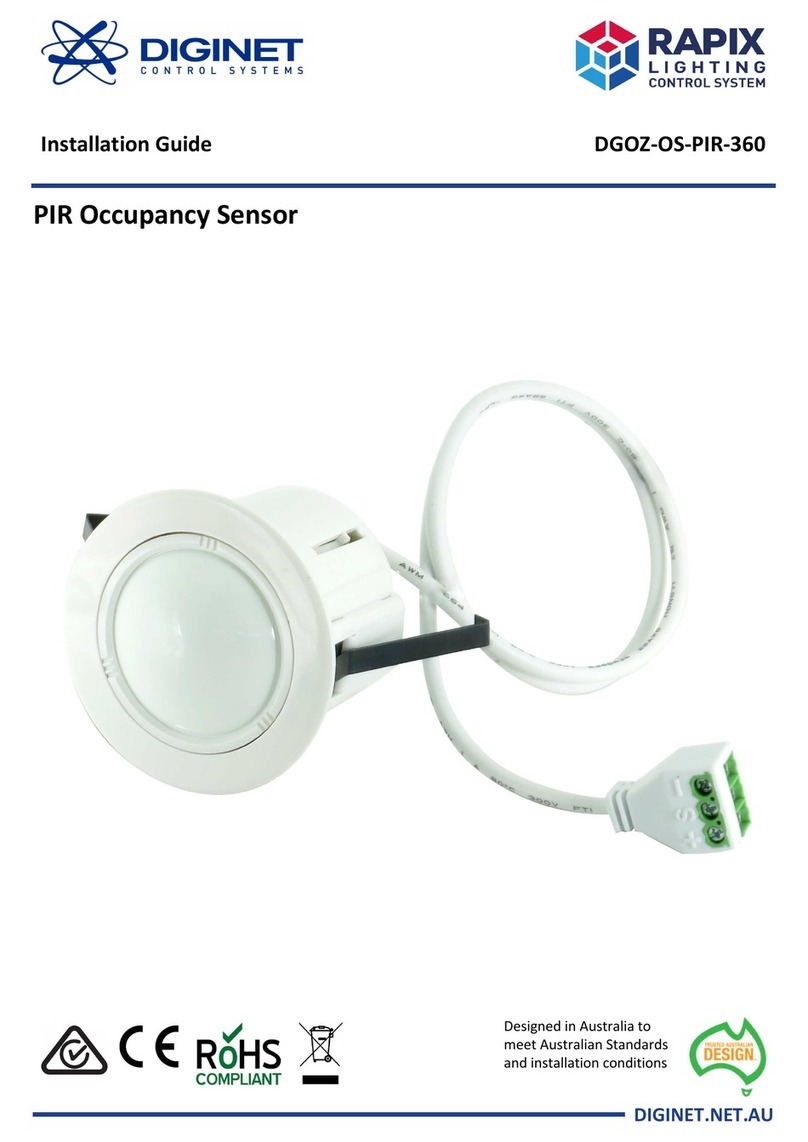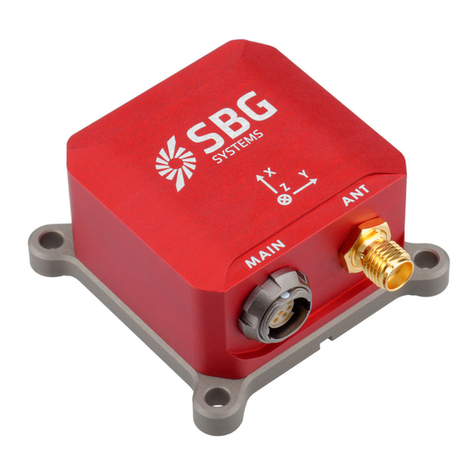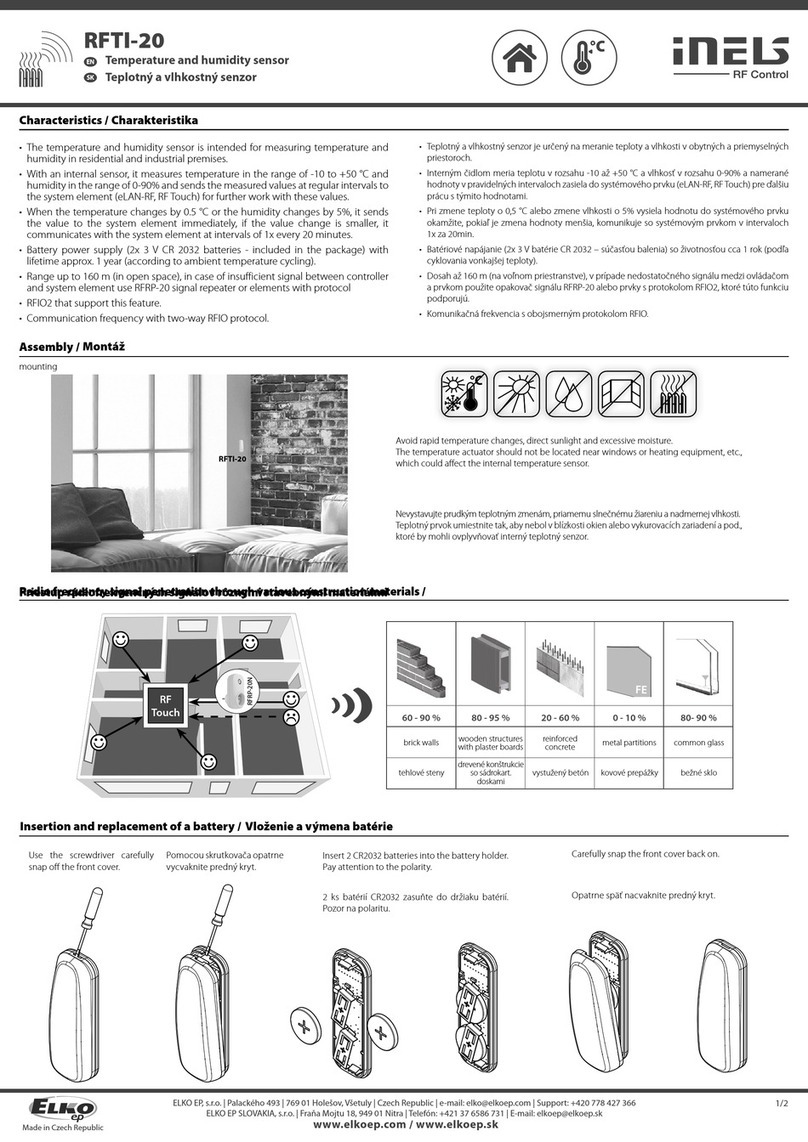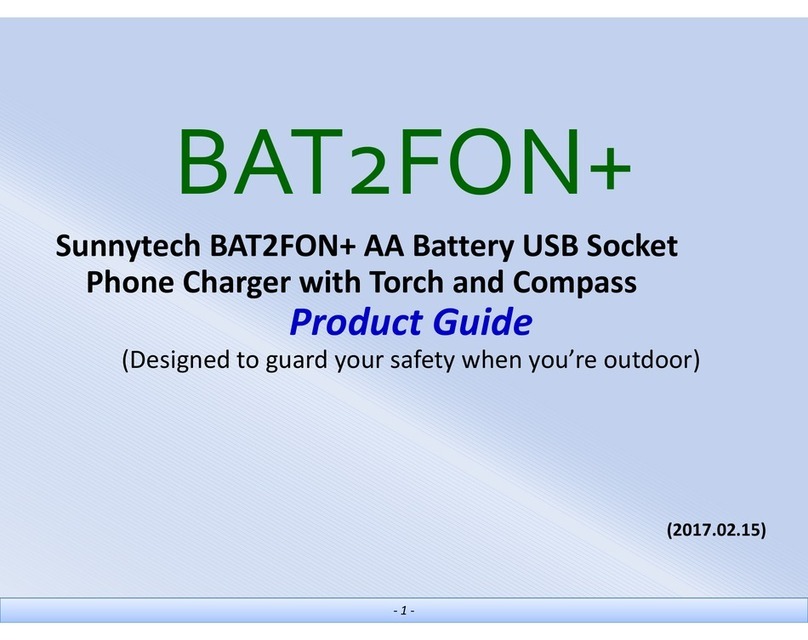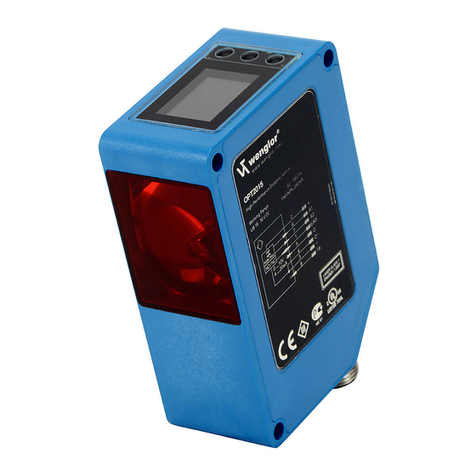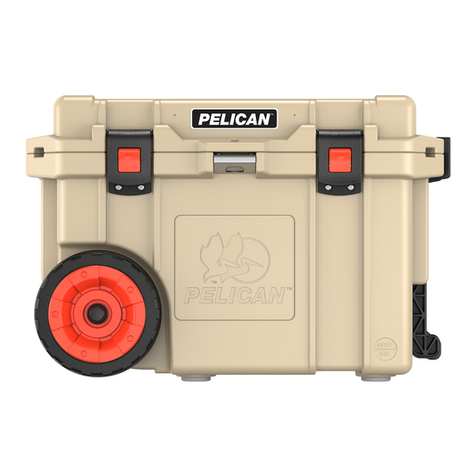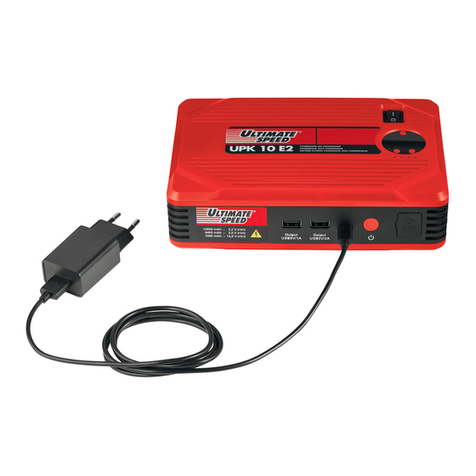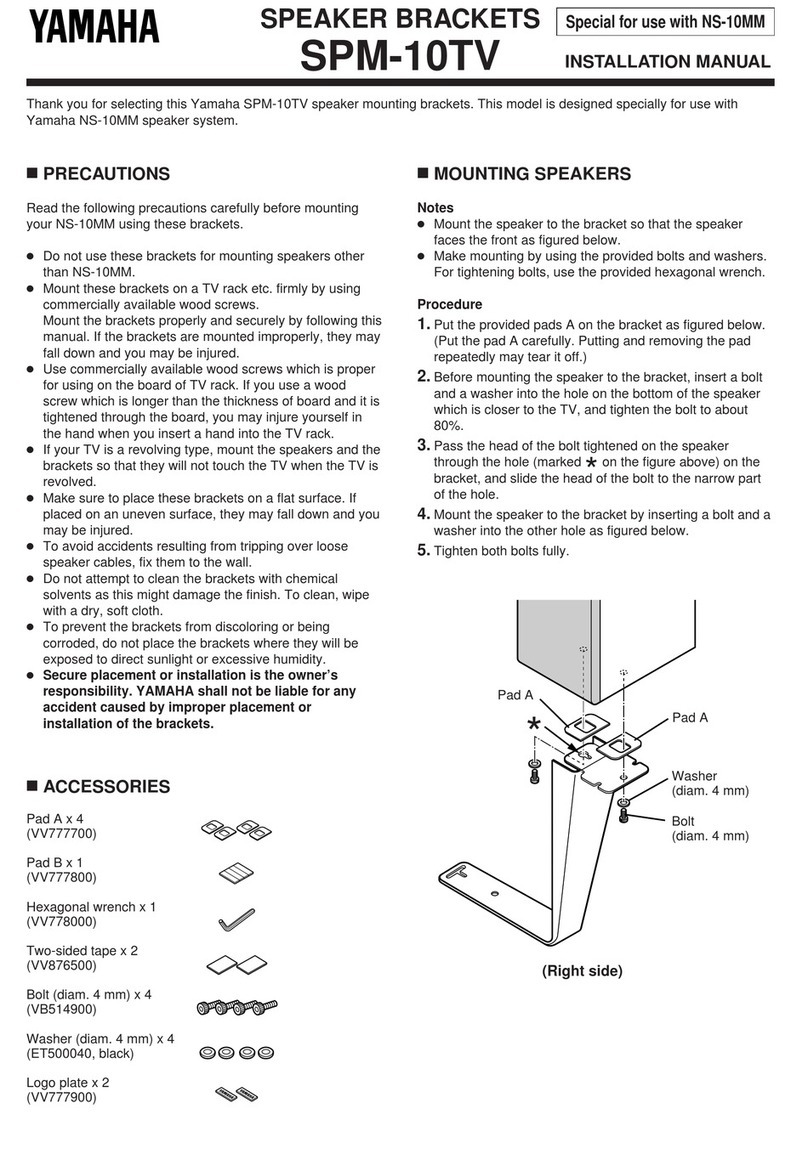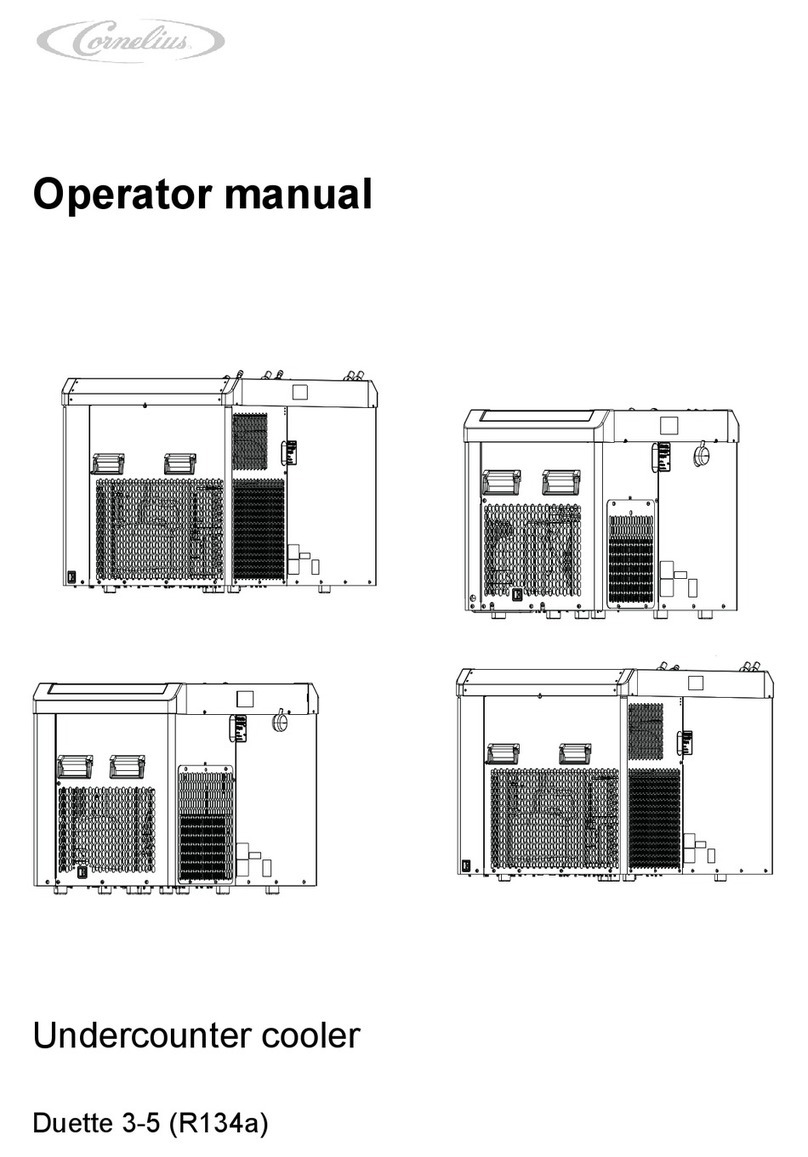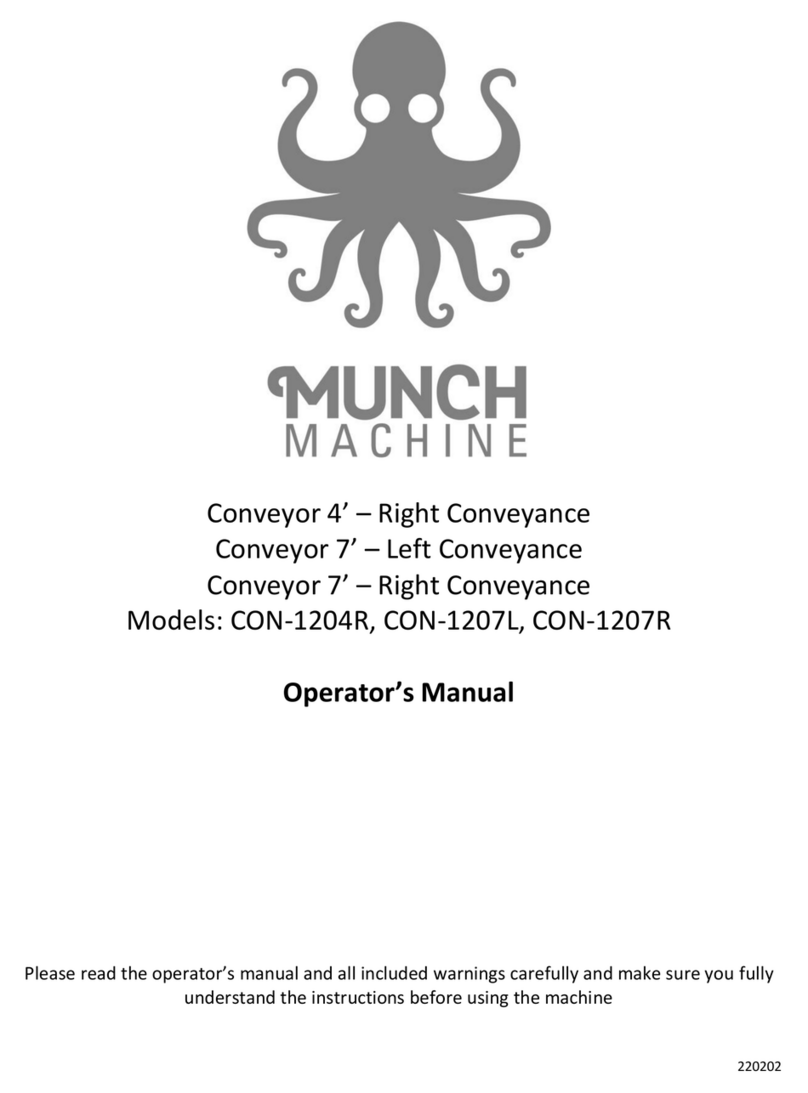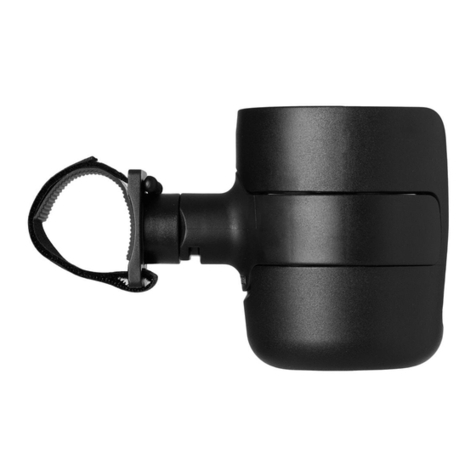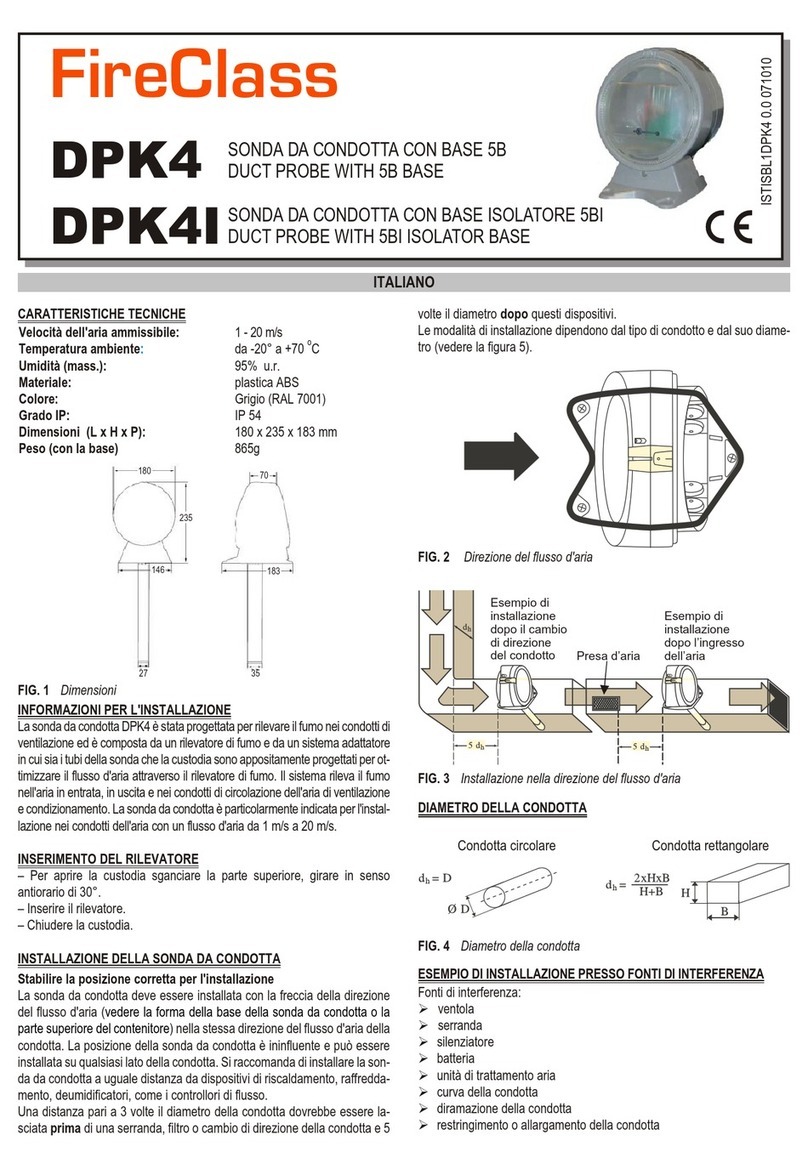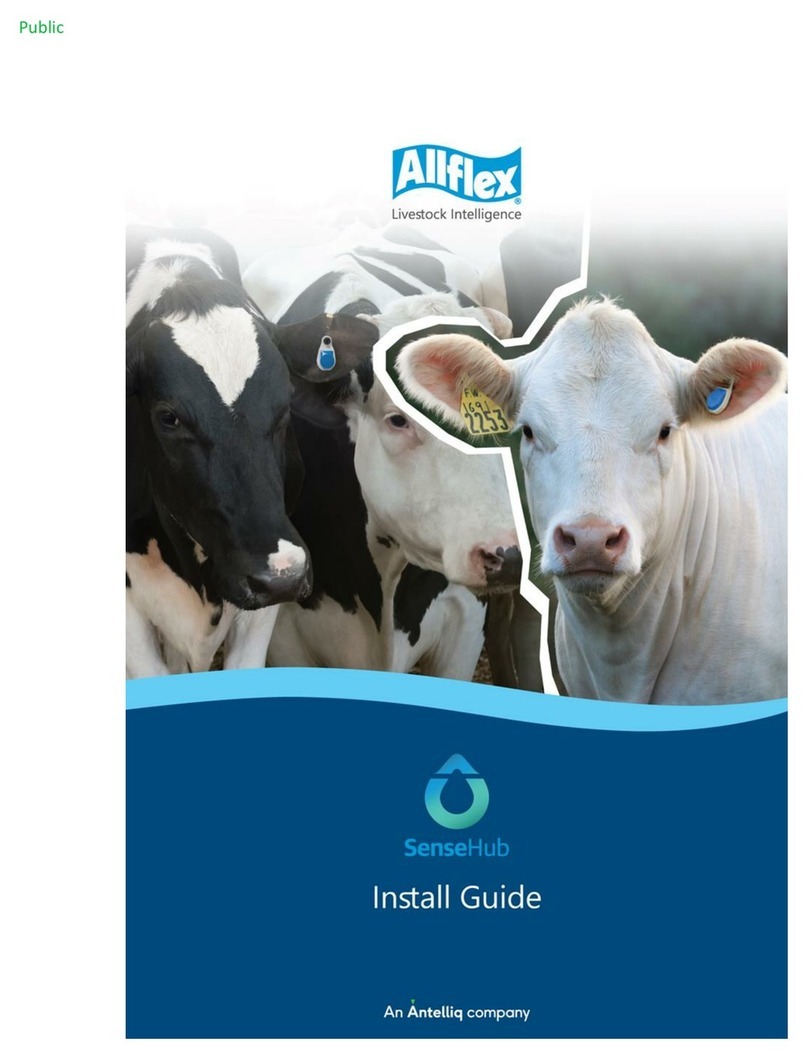AEM Lambrecht Meteo u[sonic]WS7 User manual

Manual
Weather Sensor u[sonic]WS7
(16480) u[sonic]WS7 Manual
Advantages at a Glance
■Extremely robust, compact weather sensor with high-
quality, pollutant-resistant housing made of anodized
aluminium
■Ideal for use in extreme environmental conditions, e.g.
deserts, tropics, high mountains
■Version with integrated heating system for year-round
icing-free operation
■Lamella shelter for accurate measurements of the
temperature-humidity sensors
■ASCII data protocol according to NMEA 0183
■Power supply 6...60 VDC with integrated overvoltage
protection
■Storage, evaluation and display of the measured values
using the “MeteoWare CS” evaluation software
■Easy, space-saving mounting on 50 mm standard pipe
The Perfect Weather Sensor
■For industrial use as well as under extreme environmen-
tal conditions
■6+1 parameters in one and at the same time
Wind direction
Wind speed
Air temperature
Air humidity
Barometric pressure
Global radiation
Dew point temperature (calculated value)
■With independent, integrated sensors for high accura-
cies of each individual parameter
■Without movable measuring elements, i. e. no abrasion,
low maintenance and very easy to service
Applications
•Land applications under any conditions
•Wind turbines
• Railway line monitoring
• Trac meteorology
• Weather services and Oces for the Environment
• Chemical and industrial facilities
• Power plants, sewage plants and landlls
1

Manual
Weather Sensor u[sonic]WS7
(16480) u[sonic]WS7 Manual
Contents
1 Introduction 3
1.1 Warranty 3
2 Setting to work 3
2.1 Installation conditions 3
2.1.1 Generally 3
2.2 Tools and installation aids 4
2.3 Unpacking the sensor 4
2.4 Goods inspection 4
2.5 Power supply 4
2.6 Installation procedure (short instruction) 4
2.7 Mounting 4
2.7.1 North alignment of wind sensor 4
2.7.2 Power and signal connection 5
2.7.3 Safety regulations 5
3 Maintenance 5
3.1 Regular maintenance and calibration 5
3.2 Visual check and cleaning 5
4 Transports 5
5 Dimensional drawings and electrical connections u[sonic]WS7 6
6 Data protocols u[sonic]WS7 7
7 Modbus data protocols u[sonic]WS7 8
7.1 General 8
7.2 Data encoding 8
7.3 Standard conguration - default 8
7.4 Available Modbus commands 8
7.5 Instantaneous values / realtime values (Input Register) 9
7.6 Period data - Average, maximum and minimum (Input Register) 9
7.7 Descriptive sensor parameter registers (Holding Register) 10
7.8 Sensor parameters / conguration-parameters 11
7.9 Autoconguration 11
8 SDI-12 Interface 12
9 Technical data 17
10 Disposal 17
2

Manual
Weather Sensor u[sonic]WS7
(16480) u[sonic]WS7 Manual
1 Introduction
The sensors of the u[sonic] family are very robust, compact
and extremely reliable.
The sensors embody the experience of more than 150 years
of development and production of LAMBRECHT wind sensors.
The system acquires the horizontal air ow and processes
the measuring data to the meteorological parameters wind
speed and wind direction. Furthermore the weather-module
of the u[sonic]WS7 acquires the meteorological parameters
air temperature, relative humidity, barometric pressure and
global radiation. Based on the measured data u[sonic]WS7
calculates the dew point temperature and provides for its serial
output along with the measuring data.
The sensors and further system components are mounted in
a splash water- and dust proof metal housing.
The measuring data are automatically transmitted via se-
rial interface RS-485 in talker mode, when power supply is
switched on.
Due to their shock- and vibration proof construction the sen-
sor u[sonic]WS7 is particularly qualied for use under severe
environmental conditions. The housing is made of anodised
seawater resistant aluminium.
An electronically controlled heating device enables the sen-
sor to operate in between the wide range of -40 up to 70 °C.
1.1 Warranty
Please note the loss of warranty and non-liability by unau-
thorised manipulation of the system. You need a written
permission of the LAMBRECHT meteo GmbH for changes
of system components. These activities must be operated
by a qualied technician.
The warranty does not cover:
1. Mechanical damages caused by external impacts (e. g.
icefall, rockfall, vandalism).
2. Impacts or damages caused by over-voltages or elec-
tromagnetic elds which are beyond the standards and
specications in the technical data.
3. Damages caused by improper handling, e. g. by wrong
tools, incorrect installation, incorrect electrical installation
(false polarity) etc.
4. Damages which are caused by using the device beyond
the specied operation conditions.
Static measuring principle for wind measurements means:
• Determination of data works without moving measuring
elements, i.e. none abrasion, least maintenance and none
recalibration because of this method.
• The wind parameter can be measured also in winter time
accurate and precise, because of the electronic controlled
heating for the immovable measuring elements. This
heating is particularly eective against ice and snow in all
climatic zones.
• The measuring principle allows very low starting values
and high repeat accuracy.
• The sensor rapidly can be installed. Due to the special
measuring principle minor changes from the angle of pitch
can be disregarded.
Advantages of the sensor:
• Apart from the sensors for wind speed and direction the
compact housing also contains built-in sensors for air
temperature, relative humidity, barometric pressure and
global radiation.
• The built-in test function of the station, enabled by the
tight integration of the meteorological sensors into the
enclosure, can perform cyclic self-testing and notify the
user of erroneous data or failure.
• The compact design of this sensor with 7 meteorological
parameters is eliminating the traditional cabling and instal-
lation work signicantly. Distribution boxes, power supply
units and other accessories can be reduced to a minimum
expense.
2 Setting to work
Wind can be represented by a vector quantity. For a complete
description of the wind it is necessary to specify its speed
and direction. The two components are subject to spatial and
temporal variations; thus, strictly speaking, they are valid only
for the site where the measuring instrument is installed. We
therefore recommend selecting the place of installation very
carefully.
2.1 Installation conditions
2.1.1 Generally
For professional wind measurements according to meteoro-
logical standards (e. g. VDI 3786, Part 2) location and height
of the wind sensor are important for representative and ac-
curate results. Generally, wind measuring instruments should
not measure the specic wind conditions of a limited area,
but indicate the typical wind conditions of a wider area. To
obtain results which are representative for a wider area and
comparable to values measured at dierent places, the sen-
sor must not be mounted under the lee of higher obstacles.
The distance to any obstacle should be at least 10 times the
obstacle‘s height (corresponding to the denition of an undis-
turbed area). In general a measuring height of 10 m above
ground is regarded ideal.
If an undisturbed terrain of this kind does not exist the sen-
sor have to be put up at an height of at least 6 m above the
obstacle height.
If the above mentioned requirements are not feasible e. g. on
mobile measurements at vehicles or at measuring containers
compromises have to be found and documented.
If the sensor must be installed on a roof top the place of instal-
lation must be in the middle of the roof to avoid predominant
wind directions.
3

Manual
Weather Sensor u[sonic]WS7
(16480) u[sonic]WS7 Manual
2.7 Mounting
The sensor can be installed on a standard pipe with an outer
diameter of 50 mm and an inner diameter of maximum 40 mm.
Before tightening the two M8x12 grub screws and attaching
the sensor you have to draw the cable through the pipe and
align the sensor into driving direction.
For this purpose the housing is marked accordingly (see
drawing). Before the screws of the sensor are tightened, the
sensor is adjusted to north.
Use only the supplied fixing screws and do not
tighten the north screw tightly. Please pay attention
to a rm mounting of the sensor at the mast!
2.7.1 North alignment of wind sensor
For wind direction measurements the north mark on the sen-
sor must be aligned with the geographical north direction.
To adjust the wind sensor in a rm and correct manner into
the north direction this item is equipped with an integrated
mounting aid. Inside the inner bottom of the sensor a small bolt
pointing to the north is integrated to be set into a correspond-
ing slot of the mounting pipe (if available). Thus the sensor is
safely attached. If needed you can turn in or unscrew the pin
by means of in-hex wrench.
To set up the sensor’s north orientation select a landmark
which is as far as possible up north with regard to the nal
position of the wind direction sensor.
The reference point can be selected using a topographical
map (1:25000). The exact position of the reference point is
determined using an amplitude compass that can be adjusted
horizontally on a stand.
Compass declination has to be considered!
To align the sensor ahead (on ships) locate a point outside
the ship in the landscape which is located in the ship ahead
direction respectively in the centre line or in case of the sen-
sor is mounted far away from the middle line a line parallel
to the centre line.
Once the sensor is adjusted, it can be xed with the two grup
screws. Finally the earth screw has to be connected to the
ship’s ground. Acid-free contact grease is recommended to
protect contact surfaces against corrosion.
Note: Follow all safety instructions while setting up
the sensor onto a mast.
The place of installation should not be in the
operation elds of radar devices (radar scanners
or radar transmitters), generators or antennas. We
recommend a minimum distance of 2 m to these
installations. Furthermore a minimum distance of
5 m to MF-/ HF- and Satcom- (e. g. Inmatsat, VSat)
antennas has to be kept. The maximum electric eld
intensity may not exceed 10 V/m (tested according to
EMC standard). When indicated a greater distance
should be kept.
To avoid possible measurement errors due to heat sources as
hot or warm fumes, hot surfaces etc. next to the sensor, the
mounting site should be chosen accordingly.
2.2 Tools and installation aids
There are no special tools or materials required for the instal-
lation works. All work can be carried out with commercially
available tools such as screwdrivers and in-hex wrenches.
2.3 Unpacking the sensor
The sensor is packed in a separate box, carefully protected
against mechanical inuences during transport.
Please verify that the following parts and documents are
enclosed:
· 1 sensor u[sonic]WS7
· 1 operating manual
Accessories: (depend on order size, in all cases separately
packed)
Connecting cable with plug and core cable ends
2.4 Goods inspection
Please thoroughly check the delivery with regard to complete-
ness and eventual transport damages. In case of eventual
claims please contact us in writing immediately.
2.5 Power supply
The u[sonic]WS7 has a supply voltage range of 6...60 VDC.
The sensor heater is supplied with 24 VDC and can be factory
congured to 60 W, 120 W or 200 W. 200 W assuming the
default setting.
2.6 Installation procedure (short instruction)
The installation of the sensor involves 3 steps:
(1) Mounting the cable at the sensor and if necessary
draw the cable through the mast.
(2) Mounting the sensor at the mast, but before
tightening the screws you must align the sensor to
the north.
(3) Attaching the cable to the power supply and the
signal acquisition system.
4

Manual
Weather Sensor u[sonic]WS7
(16480) u[sonic]WS7 Manual
2.7.2 Power and signal connection
The u[sonic]WS7 sensor requires a 8-pole M16 plug connec-
tor. The cable shield should be connected with both ends at
the ground wire (PE).
To reduce the risk of inductive interference the sensor
must be properly grounded (screening on both sides).
The external connection is via central connector which is
located in housing base. For further details about electrical
connection please see chapter „Connecting diagrams“.
If the sensor is mounted in correct manner and connected
with the right cable (accessory), you can attach the wires to
power supply and signal outputs to data acquisition equipment
(computer).
The typical power supply requirements of the u[sonic]WS7
sensor are 24 Volts with a maximum current drain of 50 mA.
The input range is max. 6... 60 VDC.
The heating of the u[sonic]WS7 is supplied with 24 VDC. When
the heating is activated, the current consumption increases to
a maximum of 10 A.
The output signal of the sensor corresponds to the RS-485
standard in talker mode, whereby only the transmit lines
(TX) are used. The line drivers are capable of transmitting
data over cable lengths up to 1,220 meters (4,000 feet). This
maximum distance will vary depending upon the ope-rational
environment, the wire gauge used, and the baud- rate of the
attached devices.
When the power supply of the sensor is switched on, after
5 seconds the sensor cyclically starts sending data protocols.
2.7.3 Safety regulations
Because the wind sensor often is mounted on ex-
posed locations in dangerous heights the installation
personnel has to pay attention to the relevant safety
regulations for such works. During the electrical
installation and termination works the external circuit-
breaker must be switched o. It is not permitted to
open those housings by unauthorized persons!
3 Maintenance
3.1 Regular maintenance and calibration
The sensor u[sonic]WS7 is service reduced and designed for
a very long lifetime. Recommended is a regular visual check
regarding dirt of surface caused by the weather and if so, to
clean up. The radiation sensor glass dome should be cleaned
with a soft towel at least every 2 weeks. For stubborn stains,
the glass dome can be handled with soapy water or alcohol.
If reference measurements should be necessary
stringently must be noted that a comparability of the
measured values is given only if the measurements
take place under same conditions. I.e. the reference
equipment must be used very close to the sensor!
The sensor is a measuring instrument and thus apply user
specic standards regarding period of recalibration.
Recommendation: 2 years.
3.2 Visual check and cleaning
The use of the sensor under the respective environmental
conditions requires certain steps. It is thus recommendable
to clean the outside of the housing and shelter within specic
intervals. The intervals are dependant on the environmental
conditions and the degree of soiling. We recommend a regular
sight and functional check.
In case you should be faced with any specic problems please
contact the LAMBRECHT meteo service under:
Tel.: +49-(0)551-4958-0
E-Mail: [email protected]
4 Transports
In case it is necessary to ship or to transport the sensor must
be carefully packed to prevent damages during transport.
5

Manual
Weather Sensor u[sonic]WS7
(16480) u[sonic]WS7 Manual
5 Dimensional drawings and electrical connections u[sonic]WS7
6
WeitergabesowieVervielfältigungdieserUnterlage,VerwertungundMitteilungihresInhaltsnicht
gestattet,sowienichtausdücklichzugestanden.ZuwiderhandlungverpflichtenzuSchadensersatz.
AlleRechtefürdenFallderPatenterteilungoderGebrauchsmuster-Eintragungvorbehalten.
Passingonandduplicationofthisdocument,utilizationandcommunicationof
it'scontentsprohibitedunlessdefinitelypermitted.Infringementisboundto
compensation.Allrightsreservedforpatentorregisteredpattern.
Maße ohne Toleranzangabe nach
Zust. Änderungen Datum Name Dateiname Ersatz für:
Blatt
Bl
Maßstab
Material
Bearb.
Gepr.
Datum Name
Artikelnummer
DIN ISO 2768-m
Benennung
80.16480.001000.idw
1 / 1
23.09.2019 kreitz
80.16480.001000
Oberfläche
Ultraschall Multiparameter-Sensor
WTHPS
1
A4
Norm.
Revision
A
51Ø
40
79
Male side pin assignment
Pin Pin assignment
RS 485
Pin assignment
SDI-12
Cable color
32.16470.060000
1n.c. n.c. black
2 Data - SDI-12 Data brown
3
Heating
Control
(configurable)
Heating
Control
(configurable)
red
4n.c. n.c. orange
5 Data + SDI-12 GND yellow
6n.c. n.c. green
7+ 24V AC/DC
nominal
+ 24V AC/DC
nominal blue
8- 24V AC/DC
nominal
- 24V AC/DC
nominal violet
Stecker Pinbelegung
Pin Pinbelegung RS
485
Pinbelegung
SDI-12
Kabelfarbe
32.16470.060000
1n.c. n.c. schwarz
2 Data - SDI-12 Data braun
3
Heizungs-Steuer
ung
(konfigurierbar)
Heizungs-Steue
rung
(konfigurierbar)
rot
4n.c. n.c. orange
5 Data + SDI-12 GND gelb
6n.c. n.c. grün
7+ 24V AC/DC
nominal
+ 24V AC/DC
nominal blau
8- 24V AC/DC
nominal
- 24V AC/DC
nominal lila
286,3
199
APIN 3 Heizung 26.07.2022 Curdt

Manual
Weather Sensor u[sonic]WS7
(16480) u[sonic]WS7 Manual
6 Data protocols u[sonic]WS7
NMEA Communication parameters
Baudrate: 4800 Baud
Data Bits: 8
Parity Bit: None (none)
Stop Bits: 1 (or more)
Handshake: without
Wind direction and wind speed
Example of data sequence with comma separated
elds: $WIMWV,357.0,R,5.2,M,A*CS<CR><LF>
eld delimiter: , (comma)
header: $WIMWV
wind direction: 0.0...360.0
R: relative wind direction
wind speed: 0.1...85.0
M metric units m/s
status A (valid) / V (not valid)
stop delimiters: <CR><LF>
error code: WD 999.9
error code: WS 999.9
Message string WIMTA air temperature
Example of data sequence with comma separated
elds: $WIMTA,-25.0,C*CS<CR><LF>
eld delimiter: , (comma)
header: $WIMTA
temperature: -40.0...+70.0
C: °C
stop limiters: <CR><LF>
error code: 999.9
Message string WIMHU relative humidity
Example of data sequence with comma separated
elds: $WIMHU,100.0,,-40.0,C*CS<CR><LF>
eld delimiter: , (comma)
header: $WIMHU
rel. humidity: 000.0...100.0
dew point temp.: -40.0...+70.0
C: °C
stop limiters: <CR><LF>
error code: 999.9
Message string WIMMB barometric pressure
Example of data sequence with comma separated
elds: $WIMMB,,,1050.0,B*CS<CR><LF>
eld delimiter: , (comma)
header: $WIMMB
barometric pressure: 600.0...1100.0
B: air pressure in hPa
stop limiters: <CR><LF>
error code: 9999.9
Global radiation
Example of data sequence with comma separated
elds: $WIXDR,,,500.0,W,01*CS<CR><LF>
eld delimiter: , (comma)
header: $WIXDR
global radiation: 0.0...1600.0
W: global radiation in W/m²
stop limiters: <CR><LF>
error code: 9999.9
Important! Please note:
Field length
The development of a NMEA decoder should not be pro-
ceeded from rm eld lengths. The NMEA denition proceeds
from a variable eld length. The comma character (“,”) serves
as eld disconnecting switch. Numeric values in a eld can be
presented dierently. In case a eld is not sent, it has a length
of 0 characters (,,) [comma-comma].
Check sum
The check sum “CS” is covered to two ASCII characters
hexadecimal value. “CS” calculated by XOR operation of each
character in the sentence between “$” and “*”, but excluding
“$” and “*”.
Error code
In case, that the sensor cannot generate a measuring value
because e.g. a sensor element is defect or implausible (raw)
values are collected the sensor outputs in the corresponding
data protocol the above mentioned error code (e.g. 999.9) and
sets the status from “A” (valid) to “V” (not valid).
Example: $WIMWV,999.9,R,999.9,M,V*37<CR><LF>
Particular characteristics wind direction value
Theoretically the value for the wind direction can take any
value between 0.0° and 360.0°. It should be noted, that in
a full circle the values “0.0” and “360.0” are describing the
same direction. According to the international valid recom-
mendations of the WMO (World Meteorological Organization)
in the “Guide to Meteorological Instruments and Methods of
Observation” (WMO-No.8) the wind direction value 0.0° just
has to be output at calm. The u[sonic]WS7 follows the recom-
mendation of the WMO and outputs at wind from the north the
value “360.0” respectively “0.0” at calm (lull).
7

Manual
Weather Sensor u[sonic]WS7
(16480) u[sonic]WS7 Manual
7 Modbus data protocols u[sonic]WS7
This manual covers the general Modbus specication common to all Modbus sensors from LAMBRECHT meteo. The manual
allows easy operation of all LAMBRECHT meteo Modbus sensors. Some sensors of the Modbus family oer additional regis-
ters and functions, which are described in separate documents via the registers and functions described here. The registers
and functions described in this manual are sucient for general operation of Modbus sensors in a weather station or PLC.
7.1 General
The Lambrecht meteo Modbus sensors follow the specication of the Modbus organization: “MODBUS APPLICATION PRO-
TOCOL SPECIFICATION V1.1b3”.
(See www.modbus.org).
7.2 Data encoding
MODBUS uses the “Big-Endian” format for addresses and data. This means that if a value is transmitted with a number format
which is larger than a single byte, that the “most signicant byte” is sent rst.
Example Big-Endian:
Register size value 16 - bits
0x1234 is transmitted in the sequence: 0x12 0x34.
To obtain the real measuring value, divide the received register value by the divisor (provided in 6.5, 6.6).
Values of -9999 indicate an internal sensor error.
7.3 Standard conguration - default
Baud rate: 19200 Baud
Byte frame according: 8E1 (1 start bit, 8 data bits, 1 parity bit (even parity), 1 stop bit)
RTU Sensor address: 13
Default addresses of the LAMBRECHT sensors:
Address Sensor
1 Wind speed
2 Wind direction
3 Precipitation rain[e]
4 THP
5 EOLOS IND · u[sonic]WS6
6 com[b]
7 PREOS
8 ARCO
9 u[sonic]
10 Pyranometer 2nd Class
11 Secondary standard Pyranometer
12 PT100 to Modbus converter (temperature)
13 u[sonic]WS7
7.4 Available Modbus commands
The LAMBRECHT Modbus sensors support the following commands:
• “Read Holding Register” command: 0x03 (descriptive sensor data registers)
• “Read Input Register” command: 0x04 (measured values registers)
(every measured value is to be requested individually)
• “Write Multiple Register” command: 0x10 (Write to conguration registers)
8

Manual
Weather Sensor u[sonic]WS7
(16480) u[sonic]WS7 Manual
7.5 Instantaneous values / realtime values (Input Register)
The following measured values are provided by LAMBRECHT meteo sensors.
Register address Parameter name Unit Divisor Quantity of registers Access type
30001 Wind speed m/s 10 1 Read only
30201 Wind direction ° 10 1 Read only
30401 Air temperature °C 10 1 Read only
30601 Relative humidity %r.h. 10 1 Read only
30701 Dew point °C 10 1 Read only
30801 Air pressure hPa 10 1 Read only
31401 Global radiation W/m² 10 1 Read only
Example: Retrieve wind speed
0D 04 75 31 00 01 7A C5 0D 04 02 00 1F E8 F9
LEN
6
Transmission
Query =>
Source
Master
Dest
Slave 13
Function
Read Input Register (4)
Func Desk
Address=30001, Quantity of Register=1
Checksum
OK:C57A
LEN
5
Transmission
Response <=
Source
Slave 13
Dest
Master
Function
Read Input Register (4)
Func Desk
Byte count=2
Data
00 1F
Checksum
OK:F9E8
7.6 Period data - Average, maximum and minimum (Input Register)
Register Parameter name Unit Divisor Quantity of registers Access type
30002 Wind speed average m/s 10 1 Read only
30003 Wind speed maximum m/s 10 1 Read only
30004 Wind speed minimum m/s 10 1 Read only
30202 Wind direction average ° 10 1 Read only
30203 Wind direction maximum ° 10 1 Read only
30204 Wind direction minimum ° 10 1 Read only
30402 Air temperature average °C 10 1 Read only
30403 Air temperature maximum °C 10 1 Read only
30404 Air temperature minimum °C 10 1 Read only
30602 Relative humidity average % r.h. 10 1 Read only
30603 Relative humidity maximum % r.h. 10 1 Read only
30604 Relative humidity minimum % r.h. 10 1 Read only
30702 Dew point average °C 10 1 Read only
30703 Dew point maximum °C 10 1 Read only
30704 Dew point minimum °C 10 1 Read only
30802 Air pressure average hPa 10 1 Read only
30803 Air pressure maximum hPa 10 1 Read only
30804 Air pressure minimum hPa 10 1 Read only
31402 Global radiation average W/m² 10 1 Read only
31403 Global radiation maximum W/m² 10 1 Read only
31404 Global radiation minimum W/m² 10 1 Read only
The data are valid for the period between the current request and the previous request. The maximum range of a period is
1 hour. Recalling the average value of a minimum, maximum and average group will erase the appropriate registers.
Retrieve the values of a group in the sequence minimum, maximum, average.
Use command: 0x03
9

Manual
Weather Sensor u[sonic]WS7
(16480) u[sonic]WS7 Manual
Example: Retrieve wind speed (min. max. avr.) and erase the register content
01 04 75 34 00 01 6A 08 01 04 02 00 00 B9 30 01
04 75 33 00 01 DB C9 01 04 02 00 D6 38 AE 01 04
75 32 00 01 8A 09 01 04 02 00 14 B9 3F
LEN
6
Transmission
Query =>
Source
Master
Dest
Slave 1
Function
Read Input Register (4)
Func Desk
Address=30004, Quantity of Register=1
Checksum
OK:86A
LEN
5
Transmission
Response <=
Source
Slave 1
Dest
Master
Function
Read Input Register (4)
Func Desk
Byte count=2
Data
00 00
Checksum
OK:30B9
LEN
6
Transmission
Query =>
Source
Master
Dest
Slave 1
Function
Read Input Register (4)
Func Desk
Address=30003, Quantity of Register=1
Checksum
OK:C9DB
LEN
5
Transmission
Response <=
Source
Slave 1
Dest
Master
Function
Read Input Register (4)
Func Desk
Byte count=2
Data
00 D6
Checksum
OK:AE38
LEN
6
Transmission
Query =>
Source
Master
Dest
Slave 1
Function
Read Input Register (4)
Func Desk
Address=30002, Quantity of Register=1
Checksum
OK:98A
LEN
5
Transmission
Response <=
Source
Slave 1
Dest
Master
Function
Read Input Register (4)
Func Desk
Byte count=2
Data
00 14
Checksum
OK:3FB9
7.7 Descriptive sensor parameter registers (Holding Register)
Register Parameter name Quantity of registers Remark Access type
40050 Device identication number
(15 characters)
8 (2 characters in each
register)
The returned data are
in form of a 16 byte null
terminated string
Read only
40100 Serial number
(11 characters)
6 (2 characters in each
register)
The returned data are
in form of a 12 byte null
terminated string
Read only
40150 Firmware version
(up to 25 characters)
13 (2 characters in each
register)
The returned data are
in form of a 26 byte null
terminated string
Read only
Example: Retrieve the device identication number
(The identication number shown in the example is sensor-dependent. It is only used here for demonstration purposes).
0D 03 9C 72 00 08 CA 8B 0D 03 10 30 30 2E 31 36
00.16480.000130
34 38 30 2E 30 30 31 31 33 30 00 E8 6B
LEN
6
Transmission
Query =>
Source
Master
Dest
Slave 13
Function
Read Holding Register (3)
Func Desk
Address=40050, Quantity of Register=8
Checksum
OK:8BCA
LEN
19
Transmission
Response <=
Source
Slave 13
Dest
Master
Function
Read Holding Register (3)
Func Desk
Byte count=16
Data
30 30 2E 31 36 34 38 30 2E 30 30 31 31 33 30 00
Checksum
OK:6BE8
10

Manual
Weather Sensor u[sonic]WS7
(16480) u[sonic]WS7 Manual
7.8 Sensor parameters / conguration-parameters
Register Parameter name Allowed values Quantity of registers Access type
40001 Modbus device address 1 Write only
40200 Baud rate 96 = 9600
192 = 19200
384 = 38400
1 Write only
40201 Parity 1 = even
0 = none
1 Write only
The device must be restarted after each change of a setting!
Example: Change the RTU address from 13 to 1
0D 10 9C 41 00 01 02 00 01 61 88 0D 10 9C 41 00
01 7F 41
LEN
9
Transmission
Query =>
Source
Master
Dest
Slave 13
Function
Write Multiple Register (16)
Func Desk
Address=40001, Quantity=1
Byte count
2
Register values
00 01
Checksum
OK:8861
LEN
6
Transmission
Response <=
Source
Slave 13
Dest
Master
Function
Write Multiple Register (16)
Func Desk
Address=40001, Quantity=1
Checksum
OK:417F
7.9 Autoconguration
All Lambrecht Modbus sensors oer the experienced user the possibility to implement an auto-conguration in his Modbus
master based on additional information stored in the sensor.
The necessary information can be found in the document “Lambrecht_Modbus_Autoconguration”.
11

Manual
Weather Sensor u[sonic]WS7
(16480) u[sonic]WS7 Manual
8 SDI-12 Interface
SDI-12 has to be precongured ex works.
Please specify when ordering: Id-No. 97.16470.000002 Conguration SDI-12
The communication using SDI-12 protocol via SDI-12 interface is based on the ‘SDI-12 A Serial-Digital Interface Standard for
Microprocessor-Based Sensors, Version 1.4, 2017’. The u[sonic] can be used in bus mode parallel to other u[sonic].
The following subset of SDI-12 commands were implemented into the u[sonic].
For more information on the SDI-12 protocol, please refer to the standard documentation mentioned above or the website
www.SDI-12.org.
Implemented SDI-12 commands:
Command Function Answer of the sensor
a! Acknowledge Active a<CR><LF>
aI! Send Identication allccccccccmmmmmmvvvxx...xx<CR><LF>
aAb! Change Address b<CR><LF>
aC! Start Concurrent Measurement atttnn<CR><LF>
aCC! Start Concurrent Measurement and Re-
quest CRC checksum
atttnn<CR><LF>
aD0! Send Data (Buer 0) a<data<CR><LF>
a<data><CRC><CR><LF>
aV! Start Verication atttn<CR><LF>
aX! Resetting the Addresses a<CR><LF>
a = address of the respective sensor;
Standard sensor address = 0
SDI-12 commands always start with the address of the appropriate sensor. Therefore all other sensors on the same bus will
ignore these commands. SDI-12 commands end with ‘!’. All answers from sensors start with its address, too, but end with the
ASCII characters ‘Carriage Return’ <CR> and ‘Line Feed’ <LF>.
The SDI-12 protocol is based on the ASCII character set. The baud rate of the SDI-12 protocol is 1200 Bd and has the byte
frame format:
1 start bit
7 data bits (least signicant bit transmitted rst)
1 parity bit (even parity)
1 stop bit
Acknowledge Active - a!
This command ensures that the sensor responds to requests. Basically it asks the sensor to conrm that it is connected to
the bus.
The sensor returns its address and <CR><LF>.
Syntax
Command Answer
a! a<CR><LF>
a– Sensor address a– Sensor address
!– End of command <CR><LF> – End of answer
12

Manual
Weather Sensor u[sonic]WS7
(16480) u[sonic]WS7 Manual
Example:
Command Answer
0! 0<CR><LF>
1! 1<CR><LF>
Send Identication - aI!
The command aI! is used to ask the sensor for its model number and rmware version.
Syntax
Command Answer
aI! a14LMGmbH151647011.1<CR><LF>
a– Sensor address a– Sensor address
I – Command "Send Identication"
a14LMGmbH151647011.1
14 – 2 characters SDI-12 version-No. 14 = version 1.4
LMGmbH15 – 8 characters manufacturer’s
(= Lambrecht meteo GmbH)
164701 – 6 characters sensor type
1.1 – Firmware version
!– End of command <CR><LF> – End of answer
Example:
Command Answer
0I! 014LMGmbH1514582S1.1<CR><LF>
1I! 114LMGmbH1514582D1.1<CR><LF>
Change address - aAb!
The factory setting for the address is "0".
If there are several sensors connected to one bus, the sensor address can be changed with the command aAb!.
The address is always a single ASCII character. Standard for addresses are the ASCII characters "0" to "9" (decimal 48 to
57). If there are more than 10 sensors connected to one bus, using the characters "A" to "Z" (decimal 65 to 90) and "a" to "z"
(decimal 97 to 122) is allowed. The sensor answers with its new address and <CR><LF>.
After the address is changed, one should not send further commands to the sensor for a period of one second.
(See also "SDI-12 Standard, Version 1.4, 2017")
Syntax
Command Answer
aAb! b<CR><LF>
a– Old sensor address b– New sensor address
A – Command ‘Change Address’
b – New sensor address
! – End of command <CR><LF> – End of answer
13

Manual
Weather Sensor u[sonic]WS7
(16480) u[sonic]WS7 Manual
Example:
Command Answer
0A1! 1<CR><LF>
Start Concurrent Measurement - aC!
The "Concurrent Measurement" enables the data logger to measure simultaneously with multiple sensors on the same bus.
The "aC!" command requests the sensor to process the available measurement data and write them to an output string. Unlike
the standard sensors described in the SDI-12 documentation, the u[sonic] measures continuously. This is why the u[sonic] al-
ways responds with "a000". The data is therefore immediately available. This is also the reason why the u[sonic] does not send
a "service request" and ignores measurement interruption commands. The data can be retrieved with the command "aD0!" (see
below under "Send data"). The data is not overwritten until the next "C" or "M" command and can be retrieved several times.
Syntax
Command Answer
aC! a00004<CR><LF>
a– Sensor address a– Sensor address
C – Command ‘Start Concurrent Measurement’ 000 – Seconds the sensor needs until the
measured data can be returned
(= 0 s – Data immediately available)
4– Number of provided measured data
! – End of command <CR><LF> – end of answer
Example:
Command Answer
1C! 100004<CR><LF>
The measured data can be requested with the command aD0! (see "Send Data").
Start Concurrent Measurement and Request - CRC aCC!
Same command as "aC!" but in addition to the generated data the sensor returns a 3-digit checksum. For information on how
the CRC checksum gets generated, please consult ‘SDI-12 Standard Version 1.4, 2017, chapter 4.4.12’.
Syntax
Command Answer
aCC! a00004<CR><LF>
a– Sensor address a– Sensor address
C – Command ‘Start Concurrent Measurement’ 000 – Seconds the sensor needs until the
measured data can be returned with "CRC"
(= 0 s – Data immediately available)
C – Request for transmission of the CRC checksum 04 – Number of provided measured data
! – End of command <CR><LF> – End of answer
Example:
Command Answer
1CC! 100004<CR><LF>
14

Manual
Weather Sensor u[sonic]WS7
(16480) u[sonic]WS7 Manual
Send Data - aD0!
The data requested by the sensor with the commands "C" or "M" can be retrieved with the command "aD0!". The sensor
uses the corresponding signs ("+" or "-") as eld separators. If the data was requested with a "CC" or "MC" command, a CRC
checksum is also returned. For more information on how to generate this CRC checksum, see "SDI-12 Standard, Version 1.4,
2017, chapter 4.4.12".
After the measurement, the data is stored in the buer "D0" and retrieved with the command "aD0!".
Denition SDI-12 u[sonic]WS7
C! and CC!
No. Parameter Description Unit
D0! 1 wind speed instantaneous value m/s
2 wind speed minimum value m/s
3 wind speed maximum value m/s
4 wind speed average value m/s
5 wind direction instantaneous value deg
6 wind direction minimum value deg
7 wind direction maximum value deg
8 wind direction average value deg
D1! 9 temperature instantaneous value °C
10 temperature minimum value °C
11 temperature maximum value °C
12 temperature average value °C
13 humidity instantaneous value %
14 humidity minimum value %
15 humidity maximum value %
16 humidity average value %
D2! 17 dew point instantaneous value °C
18 dew point minimum value °C
19 dew point maximum value °C
20 dew point average value °C
21 air pressure instantaneous value mbar
22 air pressure minimum value mbar
23 air pressure maximum value mbar
24 air pressure average value mbar
25 global irradiance instantaneous value W/m2
26 global irradiance minimum value W/m2
27 global irradiance maximum value W/m2
28 global irradiance average value W/m2
D3! 29 acoustic virtual temperature instantaneous value °C
30 acoustic virtual temperature minimum value °C
31 acoustic virtual temperature maximum value °C
32 acoustic virtual temperature average value °C
D4! 33 status code 8 bit value
34 error code 8 bit value
Minimal, maximum and average value refer to the time since last C! or CC! command.
15

Manual
Weather Sensor u[sonic]WS7
(16480) u[sonic]WS7 Manual
Syntax for measurements with command "aC!" or "aM!"
Command Answer
aD0! a<values><CR><LF>
a– Sensor address a– Sensor address
D– Command ‘Send Data’ <values> – Requested data separated by
0 – Request for the data in buer 0 resp. sign ("+" or "-")
or
1 = buer 1
2 = buer 2
!– End of command <CR><LF> – End of answer
Example:
Command Answer
0C! 000004<CR><LF>
0D0! 0+0.1+0.1+0.1+0.1<CR><LF>
Syntax for measurements with command "aCC!" or "aMC!"
Command Answer
aD0! a<values><CRC><CR><LF>
a– Sensor address a– Sensor address
D– Command ‘Send Data’ <values> – Requested data separated by
0 – Request for the data in buer 0 resp sign ("+" or "-")
or
1 = buer 1 <CRC> – 3-digit CRC checksum
!– End of command <CR><LF> – End of answer
16

Manual
Weather Sensor u[sonic]WS7
(16480) u[sonic]WS7 Manual
Subject to change without notice.
Dimensions: H 284 mm; Ø 199 mm; mast adapter
Ø 50 mm for mounting on standard pipe
Housing: seawater resistent aluminium;
IP 66, IP 67
Weight: approx. 3.4 kg
Standards
• NMEA 0183
• Standard of construction: VDE 0100
• Low voltage guide line: 72/23 EWG
• EMC/ EMI: DIN EN 60945 and DIN EN 61000-4-2, 3, 4, 6, 11
• Salt fog: EN 60945
• Protection class: DIN EN 60529
Accessories: (please order separately)
32.16420.066100 Sensor cable, 15 m, 8 pole M16 plug
Options: (please order separately)
36.09340.000000 Visualization and evaluation software
MeteoWare-CS3
(except for global radiation)
00.95800.010000 Data logger met[LOG]
00.14742.401002 Display unit METEO-LCD/IND
(except for global radiation)
1 Temperature inuence of the shelter: accuracy +1.5 °C at v < 2 m/s and
intensive solar radiation
2 Temperature inuence of the shelter: ± < 0.1 % r.h. at +10…+40 °C
3 Shelter inaccuracy: < 4 % r.h. dependant on v > 2 m/s and solar radiation
10 Disposal
LAMBRECHT meteo GmbH is listed and registered at the
Stiftung Elektro-Altgeräte Register ear under:
WEEE-Reg.-No. DE 45445814
In the category of monitoring and control instruments, device
type: “Monitoring and control instruments for exclusively com-
mercial use”.
Within the EU
The device has to be disposed according
to the European Directives 2002/96/EC and
2003/108/EC (Waste Electrical and Elec-
tronic Equipment). Do not dispose the old
device in the household waste! For an
environmentally friendly recycling and dis-
posal of your old device, contact a certied
disposal company for electronic waste.
Outside the EU
Please follow the regulations in your country regarding the
appropriate disposal of waste electronic equipment.
9 Technical data
(16480) Weather Sensor u[sonic]WS7
ID 00.16480.001000
Range of application: -40...+70 °C (heated: -50...+70 °C);
0...100 % r. h.
Parameters:
Wind direction
Measuring principle: ultrasonic
Measuring range: 0...359.9°
Accuracy: < 2° (>1 m/s) RMSE
Resolution: 0.1°
Wind speed
Measuring principle: ultrasonic
Measuring range: 0...65 m/s
Accuracy: 0.2 m/s RMSE(v < 10 m/s)
2 % RMSE(10 m/s < v < 65 m/s)
Resolution: 0.1 m/s
Temperature
Measuring principle: digital temperature sensor
Measuring range: -40...+70 °C
Accuracy: 0.1 K (0...60 °C) 1)
0.2 K (-40...0 °C) 1)
Resolution: 0.1 °C
Relative humidity
Measuring principle: capacitive, digital
Measuring range: 0...100 % r. h.
Accuracy: 1.5 % (0...80 %) r. h. 2)3)
2 % (>80 %) r. h.
Resolution: 0.1 % r. h.
Barometric pressure
Measuring principle: piezoresistive
Measuring range: 300...1100 mbar
Accuracy: 0.5 mbar
Resolution: 0.1 mbar
Global radiation
Measuring principle: thermoelectric
Measuring range: 0...2000 W/m²; global radiation in the
range of 285...3000 nm
Accuracy: Second class
Resolution: 0.2 W/m²
Dew point temperature
Measuring principle: passive; calculated from air tempera-
ture and humidity
Measuring range: -40...+70 °C
Resolution: 0.1 °C
Trigger threshold: 0.1 m/s
Interface: RS 485 / 422; SDI-12 (optional)
Protocols: NMEA 0183 (default);
Modbus and SDI-12 (optional)
Measuring rate: 0.1...10 Hz
Supply voltage: 6...60 VDC
heating: 24 VAC/DC ± 20 %
Current consumption: sensor: typically 50 mA at 24 VDC
heating: max. 10 A at 24 VAC/DC
Heating data: factory congurable:
60 W / 120 W / 200 W (standard)
17
16480_WS7_b-de.indd 35.22
LAMBRECHT meteo GmbH Tel +49-(0)551-4958-0
Friedländer Weg 65-67 Fax +49-(0)551-4958-312
Germany Internet www.lambrecht.net
This manual suits for next models
2
Table of contents
Other AEM Accessories manuals
